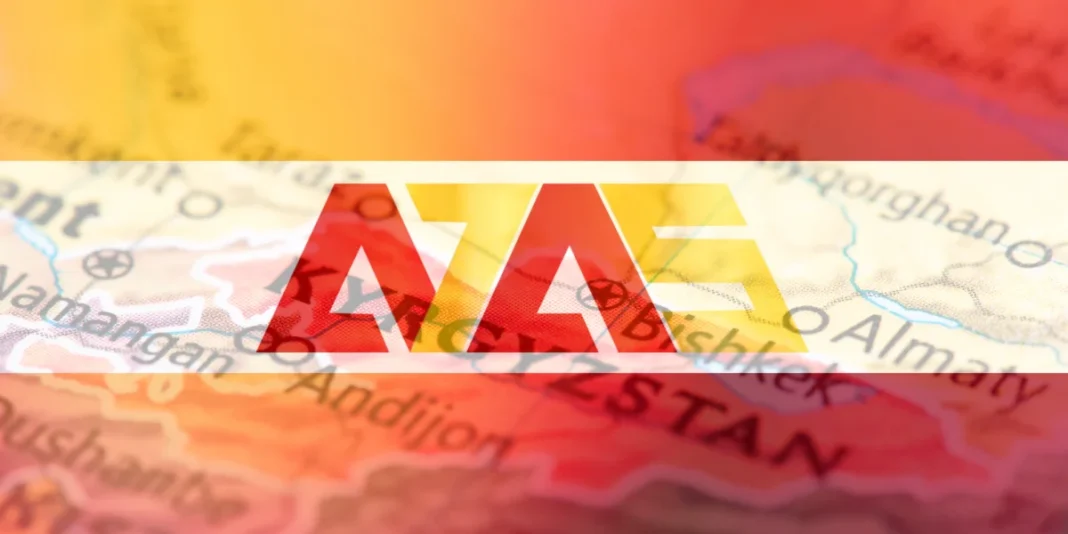Digital assets have entered a new era as Central Asia witnesses its first comprehensive crypto ecosystem. Kyrgyzstan stands at the forefront of this transformation with the launch of its national digital assets hub and the innovative A7A5 stablecoin.
The country’s bold move notably includes a robust regulatory framework and a strategic partnership with former Binance CEO Changpeng Zhao. Specifically, this initiative introduces the A7A5 stablecoin, which promises 20% annual returns through its Russian ruble pegging mechanism. The development positions Kyrgyzstan as a pivotal gateway for digital asset operations across Central Asia, attracting both regional businesses and institutional investors through its regulated trading platform, Meer Exchange.
Kyrgyzstan Unveils Comprehensive Crypto Regulatory Framework

Kyrgyzstan has established itself as a frontrunner in the cryptocurrency space by implementing a comprehensive legal framework that regulates virtual assets. The country’s regulatory approach combines innovation with security, creating a foundation for sustainable growth in the digital asset economy.
President Zhaparov Signs Landmark Digital Asset Legislation
On January 21, 2022, President Sadyr Zhaparov signed into law the groundbreaking “Law on Virtual Assets” which formally established the legal status of cryptocurrencies and related technologies in Kyrgyzstan.
This legislation represents a significant milestone in the country’s digital transformation journey, providing clear definitions and guidelines for virtual asset operations within the republic.
The law explicitly defines virtual assets as “a set of data in an electronic-digital form that holds value, representing a digital expression of value and/or a means of certifying property and/or non-property rights”. Unlike many jurisdictions that struggle with classification, Kyrgyzstan clearly categorises virtual assets as distinct from currencies, securities, and payment instruments.
Under the legislation, the government has established a licencing system for virtual asset service providers (VASPs), ensuring that only legal entities registered in Kyrgyzstan can provide virtual asset services. The law also prohibits individuals with criminal backgrounds from founding or managing crypto businesses, creating a foundation of trust and legitimacy for the sector.
How the New Framework Compares to Global Standards

In comparison with global standards, Kyrgyzstan’s approach aligns with Financial Action Task Force (FATF) recommendations while incorporating distinctive elements tailored to the Central Asian context. The regulatory framework places Kyrgyzstan amongst the 33 countries that have fully legalised cryptocurrency, setting it apart from 17 nations with partial bans and 10 with complete prohibitions.
Kyrgyzstan’s virtual assets framework includes several key provisions that mirror international best practices:
- Mandatory licencing for crypto exchanges and VASPs
- Customer due diligence requirements in line with international anti-money laundering standards
- Risk assessment obligations for service providers
- Clear definitions distinguishing virtual assets from traditional financial instruments
Furthermore, unlike some jurisdictions that have imposed blanket bans or applied existing securities laws to cryptocurrencies, Kyrgyzstan has developed a purpose-built regulatory structure specifically designed for digital assets. This approach has contributed to Kyrgyzstan’s rise to 33rd place globally in crypto adoption, making it the highest-ranked country in Central Asia and the Caucasus region.
Key Innovations in Token Issuance Supervision
One of the most innovative aspects of Kyrgyzstan’s regulatory framework is its approach to token issuance supervision. The system implements state oversight of token emissions, ensuring that digital assets comply with regulations, maintain appropriate fiat reserves, undergo periodic audits, and meet obligations to token holders.
The country’s financial regulator, the State Service for Regulation and Supervision of Financial Markets (Gosfinnadzor), maintains a Unified State Register of Cryptocurrency Exchanges. Additionally, the National Bank of Kyrgyzstan supervises VASPs, which are banks or non-banking financial institutions licenced by the central bank, creating a dual regulatory structure that enhances oversight effectiveness.
In practical terms, this regulatory innovation has already shown results. For instance, the successful issuance of the A7A5 stablecoin, which adheres to the new national legislation, demonstrates the effectiveness of the supervisory system. The token underwent complete regulatory oversight and was distributed via a registered, regulated broker, setting a precedent for compliant token issuance in the region.
Moreover, the Kyrgyz framework addresses a common global challenge in crypto regulation by implementing clear reporting obligations and mechanisms for information disclosure. These provisions help balance the need for innovation with considerations of consumer protection and financial stability, making Kyrgyzstan’s approach noteworthy in the global regulatory landscape.
The regulatory changes have coincided with significant growth in virtual asset adoption, with approximately 512,000 Kyrgyz citizens now owning crypto assets, representing around 4% of the population as of 2022, with experts suggesting this figure could reach up to 8% by 2024.
CZ Partners with Kyrgyz Government to Build Blockchain Infrastructure
In a landmark development for Central Asia’s digital finance landscape, the Kyrgyz Republic has secured technical expertise from one of the blockchain industry’s most influential figures. The partnership marks a strategic push to build robust digital infrastructure in a region increasingly focused on technological advancement.
Former Binance CEO Signs Strategic Memorandum
The National Investment Agency (NIA) under President Sadyr Zhaparov has signed a strategic Memorandum of Understanding (MoU) with Changpeng “CZ” Zhao, the founder of Binance, the world’s largest cryptocurrency exchange by trading volume. The agreement, finalised in April 2025, appoints CZ as an official advisor on national blockchain development, crypto regulation, and Web3 innovation.
“This cooperation marks an important step towards strengthening technological infrastructure, implementing innovative solutions, and preparing highly qualified specialists in blockchain technologies, virtual asset management, and cybersecurity,” President Zhaparov stated following the signing.
CZ confirmed the partnership through social media, noting: “I officially and unofficially advise a few governments on their crypto regulatory frameworks and blockchain solutions for gov efficiency, expanding blockchain to more than trading. I find this work extremely meaningful”.
The memorandum establishes formal grounds for collaboration between the former Binance chief and Kyrgyz authorities. The NIA—responsible for attracting foreign investment and assisting international companies—serves as the primary governmental body overseeing the partnership. In essence, this arrangement positions CZ as a bridge between global blockchain expertise and Kyrgyzstan’s emerging digital economy.
What Technical Expertise Will CZ Provide?
Under the agreement, CZ will deliver comprehensive support across several key areas of blockchain development. First and foremost, he will provide guidance to the Kyrgyz government on shaping a forward-looking framework for digital assets, including technical support for blockchain infrastructure and policy formulation.
The technical collaboration encompasses:
- Development of blockchain infrastructure to support the national digital economy
- Creation of a management system for virtual assets and blockchain technology in Kyrgyzstan
- Assistance in establishing a national cryptocurrency reserve
- Advisory services on regulatory frameworks aligned with global standards
Beyond infrastructure and policy development, the partnership places significant emphasis on knowledge transfer and capacity building. The agreement outlines initiatives to support education, workforce training, and cross-border knowledge exchange in blockchain-related fields. Consequently, CZ will help train young professionals, government employees, and specialists in blockchain technologies, virtual asset management, and cybersecurity.
President Zhaparov highlighted that such initiatives are “crucial for the sustainable growth of the economy and the security of virtual assets, ultimately generating new opportunities for businesses and society as a whole”.
The partnership appears particularly well-timed, given Kyrgyzstan’s natural advantages for certain blockchain operations. The country is considered ideally suited for crypto mining due to its abundant renewable energy resources. Hydroelectric power plants generate over 30% of Kyrgyzstan’s total energy supply, though only 10% of the country’s potential hydropower has been developed. This untapped clean energy capacity presents significant opportunities for energy-intensive blockchain applications.
For digital finance ecosystems already operating in the region, this move signals institutional readiness to embrace regulatory clarity and international cooperation. It sets the stage for more robust engagement between traditional institutions and blockchain-based financial systems, paving the way for compliant, scalable digital asset integration.
Through this agreement, Kyrgyzstan joins a select group of countries actively partnering with global blockchain leaders to bridge the gap between legacy systems and decentralised technologies. Implementation is now firmly on the agenda.
A7A5 Stablecoin Challenges USD Dominance in Emerging Markets
The stablecoin landscape is undergoing a significant shift as Kyrgyzstan’s A7A5 emerges as the first ruble-pegged digital asset, challenging the overwhelming dominance of USD-backed tokens.
This innovation comes at a time when dollar-based stablecoins command extraordinary market share, with USDT exceeding AUD 91.74 billion in daily trading volume and USDC handling approximately AUD 9.17 billion.
Why A7A5 Chose Russian Ruble Pegging
The decision to peg A7A5 to the Russian ruble rather than the US dollar represents a strategic departure from conventional stablecoin models. First, it addresses a critical gap in the market—non-dollar stablecoins remain severely underdeveloped, with euro-backed tokens rarely exceeding AUD 7.64-10 million in daily volume.
Similarly, stablecoins in yen, yuan, and emerging market currencies are virtually absent from major exchanges.
Beyond diversification, this pegging choice reflects economic realities. Exchange rate movements against the US dollar significantly impact emerging markets, as a large share of their credit, trade, and debt is priced in dollars.
By creating alternatives, A7A5 offers protection against currency fluctuations that often trigger capital outflows and financial instability in developing economies.
How the Stablecoin Achieves 20% Annual Returns
A7A5’s standout feature is its potential 20% annual yield—significantly higher than conventional stablecoins. This exceptional return rate stems from two primary mechanisms:
- Direct link to the Russian Central Bank’s refinancing rate, which provides a stable baseline yield
- Additional income generated through integrated DeFi strategies that amplify returns
The token maintains legitimacy through quarterly audits by independent firms, with fiat backing stored in traditional bank accounts. This combination of transparent reserve management and yield-generating strategies creates a compelling proposition for yield-seeking investors.
Target Markets Beyond Traditional Crypto Users
A7A5 targets several distinct market segments currently underserved by dollar-pegged stablecoins. Initially, it appeals to emerging market participants looking to escape the “USD trap”—the situation where economic volatility in the US creates disproportionate impacts on developing economies.
Additionally, the Stablecoin enables sophisticated investment strategies that were previously impossible in the crypto space. For instance, traditional carry trades—borrowing in low-interest currencies to invest in higher-yielding ones—have been unfeasible in DeFi due to the absence of multi-currency options. A7A5 provides the infrastructure needed for:
- Income strategies involving emerging market assets
- Currency risk hedging through derivative instruments
- Both synthetic and direct participation in real-world assets (RWA)
Therefore, A7A5 is designed for forward-thinking investors seeking alternatives in a financial landscape where traditional options increasingly offer diminishing returns.
Kyrgyzstan Positions Itself as Central Asia’s Crypto Gateway
As cryptocurrency adoption accelerates across Central Asia, Kyrgyzstan has emerged as the region’s premier digital asset hub, leveraging its progressive regulations and infrastructure investments to attract both entrepreneurs and established players.
Economic Benefits Attract Regional Businesses
The economic impact of Kyrgyzstan’s crypto-friendly approach has been substantial. The turnover of legal crypto exchanges skyrocketed from 5.2 billion soms in 2022 to an impressive 346.7 billion soms in just the first half of 2024.
This exponential growth has generated significant tax revenue, with crypto exchanges contributing 74.2 million soms in the first six months of 2024, already surpassing the 73.1 million soms collected throughout all of 2023.
Indeed, the government’s strategic vision aims to collect approximately 350 million soms annually from the crypto sector.
By 2024, Kyrgyzstan had registered 75 virtual asset exchange operators and seven full-fledged crypto exchanges, with cryptocurrency transaction volumes reaching AUD 6.42 billion.
The country’s positioning as a regional crypto hub has several distinct advantages:
- Preferential tax environment for compliant operators
- Clear legal framework reducing operational uncertainty
- Strategic location connecting East Asian and European markets
- Relatively low operational costs compared to traditional financial centres
Nevertheless, challenges remain as the sector matures. The government’s proposal to raise the sales tax on virtual asset transactions from 3% to 5% has raised concerns among market participants who already operate with razor-thin margins of 0.1%-0.15%.
Local Financial Institutions Embrace Digital Innovation
Alongside dedicated crypto businesses, traditional Kyrgyz financial institutions are rapidly integrating digital asset capabilities. Above all, MBank stands out as Kyrgyzstan’s first digital ecosystem bank, achieving remarkable growth with over 10 million mobile application downloads and serving approximately 3 million active customers—representing an astounding 80% of the country’s adult population.
The bank’s loan portfolio has expanded 400% since 2021, reaching AUD 623.83 million in 2024. With this in mind, MBank has evolved beyond traditional banking services to offer a comprehensive digital experience that includes virtual card issuance, tax payments, and vehicle re-registration services.
To clarify its international reach, MBank has established partnerships with platforms like Thunes to facilitate streamlined cross-border payments. As a result, the bank now powers over 60% of all POS terminals in Kyrgyzstan, making it the dominant player in digital transactions.
Security remains paramount in this digital transformation, with institutions implementing advanced technologies such as hyperconvergent architecture and perimeter security systems to protect customer data and transactions.
Meer Exchange Launches First Regulated Trading of A7A5
Meer Exchange has established itself as the pioneering platform for A7A5 trading, marking a critical milestone in Kyrgyzstan’s digital asset ecosystem development. In fact, this regulated exchange serves as the first official marketplace where investors can access the Russian ruble-pegged Stablecoin, creating a compliant bridge between traditional finance and decentralised technologies.
Trading Volumes Exceed Initial Expectations
The debut of A7A5 on Meer Exchange has generated substantial transaction activity, promptly outpacing projected trading volumes. Despite being a newcomer in a market dominated by USD-pegged stablecoins, the ruble-based token has attracted considerable interest.
Indeed, this achievement stands out when compared to other non-dollar stablecoins, which typically struggle to gain traction—euro-backed stablecoins rarely exceed AUD 7.64-10 million in daily trading volume.
Institutional Investors Show Strong Interest
Corporate and institutional investors have demonstrated remarkable enthusiasm for A7A5, drawn by its distinctive value proposition. Primarily, the token’s potential to yield up to 20% annually through its connection to the Russian Central Bank’s refinancing rate has captivated yield-seeking institutions. Equally important is Stablecoin’s regulatory compliance—its fiat backing undergoes quarterly audits by independent firms, creating the transparency and security institutional participants demand.
Future Decentralised Exchange Listings Planned
According to official statements, A7A5 will expand beyond Meer Exchange onto decentralised platforms in the coming months. This strategic move aims to broaden accessibility while maintaining the token’s regulated status.
In other words, the dual presence of centralised and decentralised exchanges will enhance liquidity opportunities for traders across different ecosystems.
Once listed on DEXs, A7A5 will enable broader participation in:
- Income strategies involving emerging market assets
- Currency risk hedging through derivative instruments
- Both synthetic and direct engagement with real-world assets via blockchain infrastructure
Currently, the token’s fiat backing remains securely stored in traditional bank accounts, with transaction monitoring and regular compliance checks ensuring its ongoing legitimacy within Kyrgyzstan’s regulatory framework.
Wrapping Up
Kyrgyzstan’s bold entry into the digital asset space marks a significant shift in Central Asia’s financial landscape. The country’s comprehensive regulatory framework, coupled with CZ’s strategic guidance, establishes a solid foundation for sustainable growth in the region. Above all, the A7A5 stablecoin stands as a testament to this innovation, offering unprecedented 20% annual returns through its Russian ruble pegging mechanism.
The success of Meer Exchange undoubtedly validates Kyrgyzstan’s approach. It has attracted substantial institutional interest and exceeded initial trading expectations. Consequently, the country’s tax revenues from crypto operations have grown exponentially, with exchanges contributing 74.2 million soms in just six months of 2024.
Therefore, Kyrgyzstan’s emergence as Central Asia’s premier digital asset hub represents more than just technological advancement. The nation has created a blueprint for regulated crypto innovation, balancing security with growth while fostering institutional adoption. This strategic positioning, supported by clear regulations and robust infrastructure, sets the stage for Kyrgyzstan’s continued leadership in the global digital asset ecosystem.






